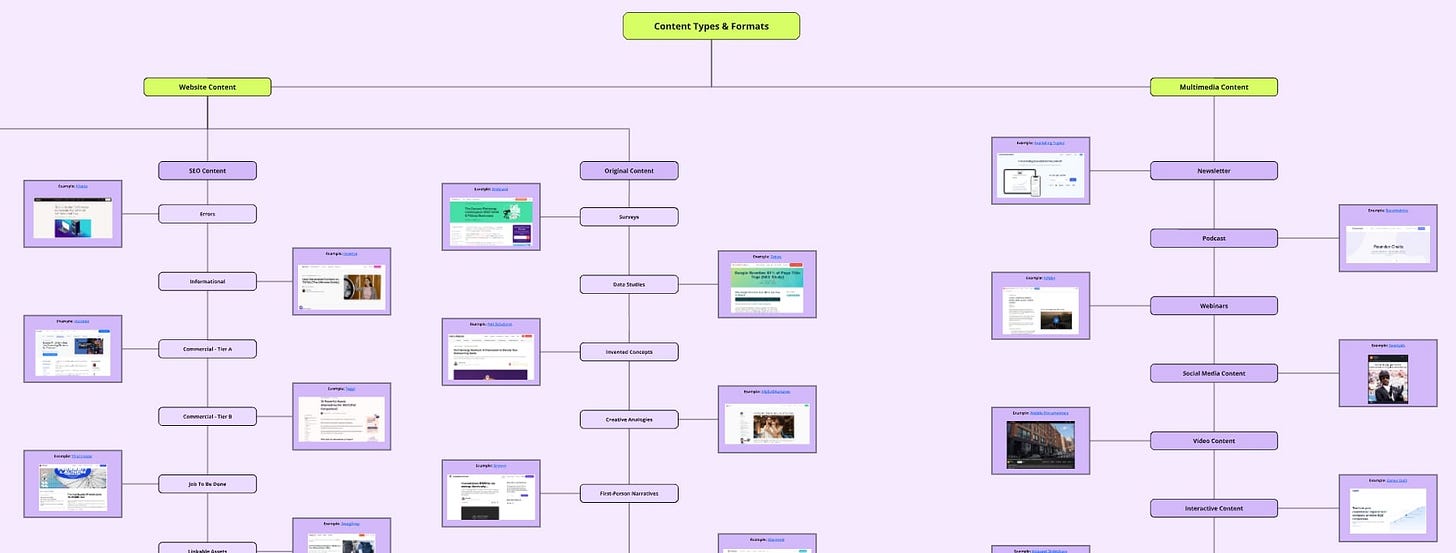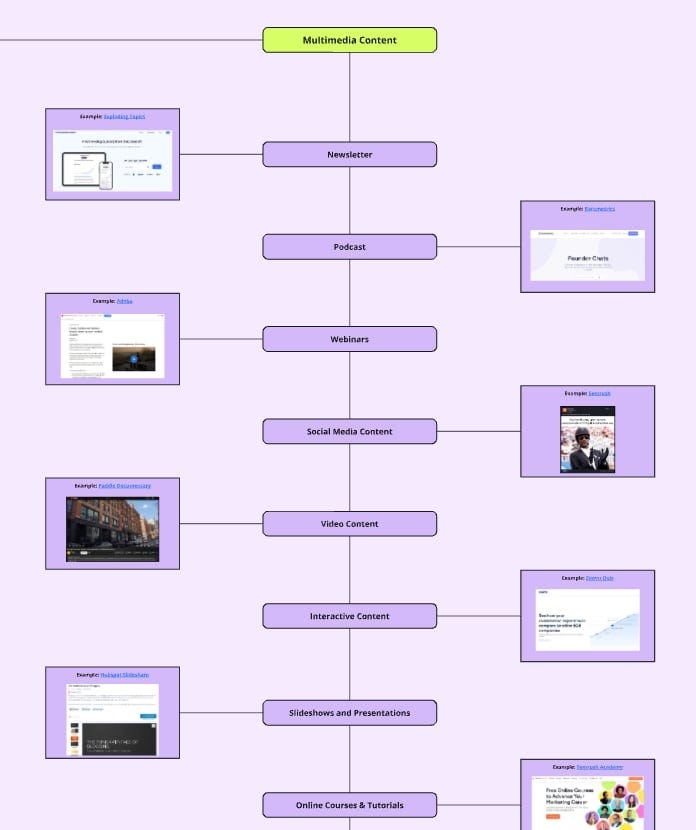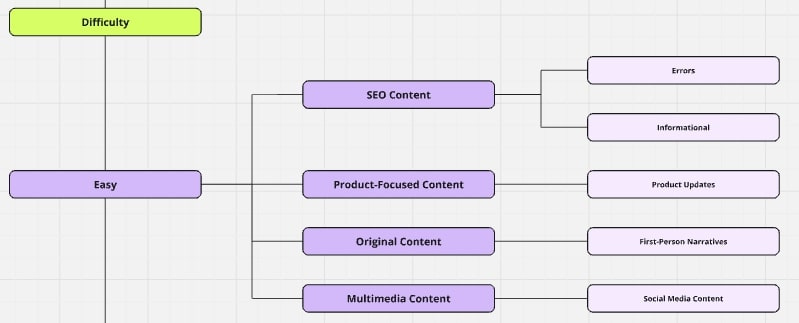A framework I developed
The framework we use at Minuttia to drive growth through content
👋 Hey, I’m George Chasiotis. This note is available only to GrowthWaves Pro readers. You can upgrade to Pro to receive an additional monthly note, access our Premium Archive and Video Library, attend our Live Sessions and Events, get access to 20+ Software Discounts, and post to our job board.
In today’s Note, we are stepping away from case studies for a moment.
Instead, I want to present you with the SaaS Content Mapping Framework.
It is a framework me and my team at Minuttia use everyday to develop successful content marketing strategies for our SaaS clients. It came together through years of working in the industry, experimenting, and finding new, more efficient, and more effective ways of helping companies grow.
The framework recently underwent yet another evolution, so I am proud to be able to break down the latest version for you here.
If you want a more interactive AI experience, we also created the GPT version of this framework.
Key findings (TL;DR)
Our SaaS Content Mapping Framework categorizes content into two major groups: website content (such as product-focused, SEO, and original content) and multimedia content (such as videos, podcasts, webinars, etc.).
A well-rounded content marketing strategy has eight dimensions: company stage, competition, objective, difficulty, budget, lifecycle stage, distribution, and growth motion.
Each stage is best served by specific content types and formats, which you will find listed in the SaaS Content Mapping Miro board or the content marketing strategy GPT linked to above.
Content Types & Formats
First, we need to determine which content types and formats can be used in a content marketing strategy.
Here’s how I see it: there are two major content type groups – website content and multimedia content.
Website content
For the lack of a better name, we define website content as all written content that can be found on a company website (not only on the blog).
Broadly speaking, website content can be divided into three sub categories:
Product-focused content – As the name suggests, this includes all content formats relating closely to the product itself, such as product update articles, case studies, comparison guides with competitor products, etc.
SEO content – The well-known and well-worn group of content formats created to target specific keywords and rank high in search engine results.
Original content – Content unique to the brand, created for purposes other than to acquire organic traffic (though it certainly can do that, too). Think data studies, contrarian content, surveys, first- and third-person interviews and narratives, and similar.
Check out the Miro board above for detailed lists of which content formats belong to which of these categories, with examples.
Multimedia content
Multimedia content includes content formats that may not immediately come to mind when you say content marketing. Indeed, these content formats are often overlooked, yet they hold the most potential for growth and differentiation from competition.
We’re talking about content that includes written segments, such as newsletter content and social media content, but also content with images, videos, audio, live streams, interactive content, and more.
Content strategy dimensions
Now that we’ve established the different content types and formats available to us, we can think about building a content strategy.
In my experience, a content marketing strategy is defined by eight dimensions:
Company stage
Competition
Objective
Difficulty
Budget
Lifecycle stage
Distribution
Growth motion
Which specific content types and formats you will use in your strategy depends on each of these dimensions.
Let’s take a closer look at them.
1. Company stage
A SaaS company can find itself in one of three stages:
Early stage – The company is developing an MVP, conducting research to understand its target audience and their pain points, securing seed funding, building the core team, etc.
Product-market fit – The best use cases for the product have been identified and now the company is refining the product, working on increasing customer retention and satisfaction, and scaling customer acquisition.
Growth stage – This stage is characterized by rapid expansion both in infrastructure and operations, optimizing the business model for sustained growth, and further increasing marketing and sales efforts.
Each company stage benefits from specific content types and formats.
For example, early stage companies should focus on building brand awareness, drawing in early adopters, validating product-marketing fit, etc. Extensive data studies are probably not the best content format for this stage. Case studies, customer stories, and network-based content, on the other hand, are a great option.
Refer to our Miro board for the full list of which content types and formats work for which company stages.
2. Competition
In this dimension, we are not talking about the competitiveness of your space.
Rather, we are talking about how competitive each content type or format can be.
For example, all original content formats are not too competitive. Why? Because they are unique to the brand creating them.
Mailchimp might create a data study, but it will be a completely different data study than, say, one created by ActiveCampaign. These two platforms will pull from different data sources and will likely aim to answer different questions, therefore creating two pieces of content that don’t compete but rather coexist with each other.
The same cannot be said for any type of SEO content, where hundreds of content pieces are competing for the same handful of ranking spots in Google.
3. Objective
Your content marketing strategy can have one or more objectives. Here are the top five objectives we most commonly notice in our client work:
Increasing brand value – Improve the perception and reputation of your brand within your target market.
Thought leadership – Establish your brand or key personnel within your brand as experts in your field through producing insightful, authoritative content.
Amplification – Expand the reach of your brand to a wider audience; increase visibility and engagement.
Generating revenue – Drive sales and revenue growth directly through content marketing efforts.
Educating and supporting – Provide valuable information and resources to help your audience understand their problems and how they can best resolve them (with or without using your product).
As with company stages and competition levels above, each of these objectives is best served with specific content types and formats.
Keep in mind that one content type or format usually works for more than one objective. This is where you need to consider other aspects of your business and strategy to determine which ones are best suited to your specific case.
4. Difficulty
Some content formats are easier to create than others. For example, writing a quick 500-word product update post is a lot less time- and resource- consuming than producing an entire webinar.
When building your content marketing strategy, consider the following questions:
What skills does your in-house team excel in?
How much time can your team realistically dedicate to content creation on a regular basis?
What tools and software do you have available for content creation?
Do you have access to designers, videographers, or other specialists needed for certain types of content?
Do you have the infrastructure to support the production of high-quality content (e.g., studio space, recording equipment)?
What is your budget for outsourcing content creation, if needed?
These are all important questions to answer when determining the level of difficulty you are comfortable with in terms of content creation.
5. Budget
Each company has its own unique capabilities, meaning that it can produce different content types by investing different amounts of money.
Still, we grouped all content types and formats according to how much they could cost into three categories: low budget, medium budget, and high budget.
You can see the detailed categories in the Framework Miro board.
Podcast episodes are usually considered expensive, but maybe not if you already have a skilled audio producing team in house. Perhaps then you will have to invest more of your budget into setting up and releasing an email newsletter issue in regular intervals.
6. Lifecycle stage
In the acquisition phase of a typical customer lifecycle in the B2B industry, the customer goes through the following five stages:
Unaware – Potential customers are unaware of their problem or need. They don’t know that a solution like yours exists. They are not actively seeking information related to your industry or product.
Problem aware – Potential customers recognize they have a problem or need but are not yet aware of potential solutions. They are likely consuming content that helps define or elaborate on their issues.
Solution aware – Potential customers know that solutions to their problem exist but are not yet familiar with specific products. They are actively researching different types of solutions to address their needs.
Product aware – Potential customers are aware of specific products, including yours, and are evaluating their options. They are comparing features, benefits, and pricing of different offerings.
Most aware – In this stage, the potential customer typically interacts with the company directly or is conducting search through Transactional or Navigational queries. Therefore, none of the content types and formats we outlined above are suitable for this stage.
As with everything, different content types or formats are more suitable for different customer lifecycle stages.
For example, a person who is not yet aware of their issue won’t be well-served with a detailed case study of your product. But someone who is actively looking for solutions for their issue most definitely will.
7. Distribution
While creating high-quality content is important, distribution of that content is equally, if not more, important for the content marketing strategy to succeed.
In the Framework, we’ve listed nearly 20 different distribution channels you should consider for distributing content.
Of course, there is a fine line between content distribution and content repurposing. Some of what we outline here as distribution actually belongs in the repurposing bucket – for example, promoting a content piece on social media inevitably includes repurposing some sections of that content piece for the social media platform.
Nevertheless, we did our best to stay within the boundaries of distribution.
8. Growth motion
We can recognize three separate growth motions for a company:
Product-led growth (PLG) – The product itself is the primary driver of customer acquisition, expansion, and retention. Users typically experience the value of the product through free trials, freemium models, or self-serve onboarding, which drives them to upgrade to paid versions.
Product-led sales (PLS) – A hybrid approach that combines elements of PLG with direct sales efforts. The product still plays a crucial role in attracting and engaging users, but there is a significant emphasis on sales teams to convert users and upsell.
Sales-led growth (SLG) – The sales team drives customer acquisition, expansion, and retention. They actively engage with prospects to understand their needs, provide tailored solutions, and close deals.
Refer to the Framework for explanations of which content types and formats work best for which growth motion.
Conclusion
I hope that this Framework helps you in your future work by providing you with a comprehensive approach to developing a content marketing strategy.
Don’t forget to regularly review and update your strategy as your company evolves and market conditions change.
Additionally, don’t be afraid to experiment, analyze results, and keep refining.
Thank you for reading this Note and checking out the SaaS Content Mapping Framework.
See you next week!




